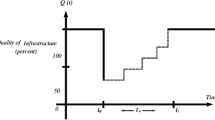Abstract
The water supply network (WSN) system is a critical element of civil infrastructure systems. Its complexity of operation and high number of components mean that all parts of the system cannot be simply assessed. Earthquakes are the most serious natural hazard to a WSN, and seismic risk assessment is essential to identify its vulnerability to different stages of damage and ensure the system safety. In this paper, using a WSN located in the airport area of Tianjin in northern China as a case study, a quantitative vulnerability assessment method was used to assess the damage that the water supply pipelines would suffer in an earthquake, and the finite element software ABAQUS and fuzzy mathematic theory were adopted to construct the assessment method. ABAQUS was applied to simulate the seismic damage to pipe segments and components of the WSN. Membership functions based on fuzzy theory were established to calculate the membership of the components in the system. However, to consider the vulnerability of the whole system, fuzzy cluster analysis was used to distinguish the importance of pipe segments and components. Finally, the vulnerability was quantified by these functions. The proposed methodology aims to assess the performance of WSNs based on pipe vulnerabilities that are simulated and calculated by the model and the mathematical method based on data of damage. In this study, a whole seismic vulnerability assessment method for a WSN was built, and these analyses are expected to provide necessary information for a mitigation plan in an earthquake disaster.
Similar content being viewed by others
References
Tierney K J. Improving earthquake loss estimation: review, assessment and extension of loss estimation methodologies. MCEER Research Progress and Accomplishments, 2000, 12–27
Newmark N M. Problems in wave propagation in soil and rock. Civil Engineering Classic, ASCE, New York: American Society of Civil Engineers, 1967, 703–722
Katsumi M, Masaru H. Soil spring constants of buried pipelines for seismic design. Journal of Engineering Mechanics, 2000, 126(1): 76–83
Yasuo O, Takeshi K. Structural design of buried pipelines for severe earthquakes. Soil Dynamics and Earthquake Engineering, 2001, 21(3): 199–209
Marco A T, Jose A C. A lifeline vulnerability study in Barcelona Spain. Reliability Engineering & System Safety, 2003, 80(2): 205–210
Limura S. Simplified mechanical model for evaluating stress in pipeline subject to settlement. Construction & Building Materials, 2004, 18(6): 469–479
Ezell B C. Quantifying Vulnerability to Critical Infrastructure. Norfolk: Old Dominion University, 2004
Omar P P. New perspectives on the damage estimation for buried pipeline systems due to seismic wave propagation. Lifeline Earthquake Engineering in a Multihazard Environment, 2009, 357(74): 781–790
Applied Technology Council (ATC). A Model Methodology for Assessment of Seismic Vulnerability and Impact of Disruption of Water Supply Systems, Report No. ATC-25-1. Redwood City, California: Applied Technology Council (ATC), 1992
Zhao B, Taucer F. Performance of infrastructure during the May 12, 2008 Wenchuan Earthquake in China. Journal of Earthquake Engineering, 2010, 14(4): 578–600
Liu A. Response analysis of a submarine cable under fault movement. Earthquake Engineering and Engineering Vibration., 2009, 8(1): 159–164
Chen S, Fu G. A fuzzy approach to the lectotype optimization of offshore platforms. Ocean Engineering, 2003, 30(7): 877–891
Chen S, Fu G, Wang J, Liu G. Fuzzy optimum model of semi-structural decision for lectotype optimization of offshore platforms. China Ocean Engineering, 2001, 15(4): 453–466
Park G, Cudney H H, Inman D J. Feasibility of using impedance-based damage assessment for pipeline structures. Earthquake engineering & structural dynamics, 2001, 30(10): 1463–1474
He S H, Li Z P, Zhang X Z. Seismic Performance Analysis of Buried Pipeline. Advanced Materials Research, 2011, 255: 2466–2470
Hibbit K A S. ABAQUS Theory and User Manuals Version 6.9. Rhode Island: ABAQUS Inc, 2009
Ghrib F, Tinawi R. An application of damage mechanics for seismic analysis of concrete gravity dams. Earthquake Engineering & Structural Dynamics, 1995, 24(2): 157–173
Malik P, Hahn W F, Hinton B M, Howard G E, Walton W B, Chitty D E. Testing and Analysis of Feedwater Piping at Indian Point Unit 1 Volume 1: Damping and Frequency. California: Electric Power Research Institute, 1983
Wen B Q, Huang Y. Metal Materials Manual. Beijing: Publishing House of Electronics Industry, 2009, 35–37 (in Chinese)
Standardization Administration of the People’s Republic of China. GB/T13295-2008: Ductile Iron Pipes, Fittings and Accessories for Water or Gas Applications. Beijing: Standards press of China, 2008
Li J, Liu W. Large-scale urban network seismic reliability analysis and optimization. Earthquake Engineering and Engineering Vibration, 2006, 26(3): 172–175 (in Chinese)
Pitilakis D K, Kakderi G K. Seismic risk assessment and management of lifelines, utilities and infrastructures. 5th International Conference on Earthquake Geotechnical Engineering, 10–13 January, 2011, Santiago, Chile. Available online at http://www.vce.at/SYNER-G/pdf/publications/5ICEGE-Pitilakis%20-%20theme%20lecture.pdf (accessed December 2, 2013)
Davis C A, Bardet J P. Responses of buried corrugated metal pipes to earthquakes. Journal of geotechnical and geoenvironmental engineering, 2000, 126(1): 28–39
Muleski G E, Ariman T. A shell model for buried pipes in earthquakes. International Journal of Soil Dynamics and Earthquake Engineering, 1985, 4(1): 43–51
Hosseini M, Moshirvaziri H. A procedure for risk mitigation of water supply system in large and populated cities. The 14th World Conference on Earthquake Engineering, 12–17 October, 2008, Beijing, China. Available online at http://www.iitk.ac.in/nicee/wcee/article/14_06-0136.PDF (accessed August 12, 2012)
Author information
Authors and Affiliations
Corresponding author
Rights and permissions
About this article
Cite this article
Chen, Y., Niu, Z., Bai, J. et al. Seismic vulnerability assessment of water supply network in Tianjin, China. Front. Environ. Sci. Eng. 8, 767–775 (2014). https://doi.org/10.1007/s11783-014-0632-6
Received:
Accepted:
Published:
Issue Date:
DOI: https://doi.org/10.1007/s11783-014-0632-6




